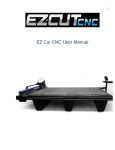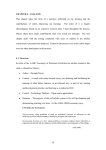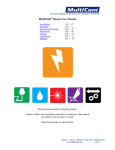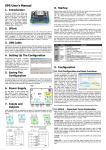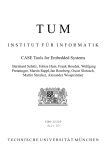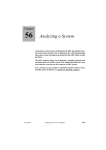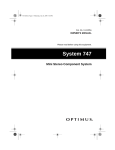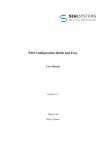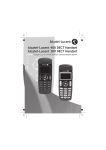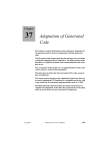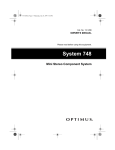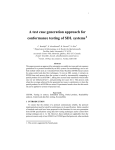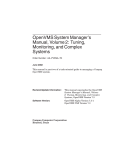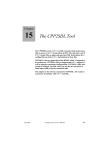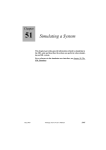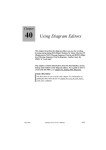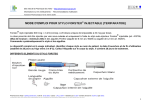Download 13 Using the Telelogic Tau Public Interface
Transcript
Chapter
13
Using the Telelogic Tau
Public Interface
This chapter contains a number of examples of how the use the features provided by the Telelogic Tau Public Interface.
For a reference to the topics that are exemplified in this chapter, see
chapter 12, The Telelogic Tau Public Interface.
July 2003
Telelogic Tau 4.5 User’s Manual
,um-st1
675
Chapter
13
Using the Telelogic Tau Public Interface
Introduction
The first example shows a simple application, the Service Encapsulator,
by which it is possible to request Telelogic Tau tools services from the
Operating Systems command line. The example shows how to use the
PostMaster interface.
The second example uses the Service Encapsulator and shows the usage
of some SDL suite Services. Since the “DOS” command prompt is rather weak in its scripting capabilities, no example script file is included
for Windows in this example.
The third example uses the Service Encapsulator and shows the usage
of some TTCN Suite Services.
The final example exemplifies how to integrate an SDL simulator and a
separate user interface (UNIX only). How to design such a user interface
is described in a detailed example. It is assumed that the reader has experience of creating and running SDL simulators.
The Service Encapsulator
Introduction to the Service Encapsulator
This section shows an application, the Service Encapsulator, implementing a command line service request encapsulation. That is, Telelogic Tau services as made available by the Telelogic Tau Public Interface, could be obtained from the command line.
The purpose of this example is to show:
•
How the PostMaster interface is used when working with Telelogic
Tau services.
•
By using the Service Encapsulator, show the usage of a number of
services.
The application is general in the sense that it does not require a Telelogic Tau tool to be running (only the PostMaster is required to be running),
but in this context it exemplifies a number of Telelogic Tau services.
From the outside world the application behaves like a tool providing remote procedure call functionality. That is, when the service is request-
676
,um-st1
Telelogic Tau 4.5 User’s Manual
July 2003
The Service Encapsulator
ed, the application synchronously waits for the service reply, before returning (the application exits).
The example is found in the Telelogic Tau distribution in the subdirectory examples and then public_interface.
The Service Encapsulator is also available as a tool in the Telelogic Tau
environment, see “The Service Encapsulator” on page 537 in chapter
12, The Telelogic Tau Public Interface.
Design
In this section is a few important aspects in the design and implementation of the Service Encapsulator given. The source file is named
serverpc.c and the executable is named serverpc.
The tool connects to the PostMaster by issuing:
SPInit(SET_EXTERN, argv[0], spMList) (in SDL suite)
SPInit(IET_EXTERN, argv[0], ipMList) (in TTCN suite)
The first parameter gives the type of application. In this case
SET_EXTERN or IET_EXTERN is used. This application type is a predefined tool type for external applications connecting to Telelogic Tau.
The variable spMList or ipMList gives the possibility to convert between textual (symbolic) values and integers.
If SPInit succeeds, SPInit broadcasts a SESTARTNOTIFY, indicating
to all other tools in the environment that an additional tool is connected.
if ((tool=atoi(argv[1])) == 0 )
tool = SPConvert(argv[1]);
If the parameter <tool> was given textually, the function SPConvert
converts it to the corresponding integer value. If a mapping cannot be
found, -1 is returned. This is an error and will be detected in the
SPSendToTool function, see below.
if ((sendEvent=atoi(argv[2])) == 0 )
sendEvent = SPConvert(argv[2]);
July 2003
Telelogic Tau 4.5 User’s Manual
,um-st1
677
Chapter
13
Using the Telelogic Tau Public Interface
Allocating memory for the message parameter is done as follows:
for (i=3;i<argc;i++) {
p = realloc(p, strlen(p) + strlen(argv[i]) + 2);
if (strlen(p)>0)
p = strcat(p, " ");
p = strcat(p, argv[i]);
}
The handleescape function allows carriage return “\n”, “\r” and
“\0” to be used when sending messages:
p = handleescape(p);
A normal service request is issued by:
status=SPSendToTool(tool, sendEvent, p, strlen(p)+1;
The last parameter tells the length of the parameter provided by
argv[3] and must be extended by 1 to include the terminating \0 character.
Now the service request message is sent to the PostMaster which forwards it to the server application. If not busy, the Service application
starts to process the service request and when finished it replies with a
service reply message to the issues. However, during the processing
other messages can be sent or broadcast to the Service Encapsulator
(the service issuer). Therefor we must enter a loop where we stay until
the reply message is received. Other kind of messages are dropped.
do {
if (( status=SPRead(SPWAITFOREVER, &pid,
&replyEvent,(void*)&replyMessage, &len))!=0
)
OnError(“Error reading from postmaster: “);
} while ( ! SP_MATCHREPLY(sendEvent, replyEvent) );
The function SPRead reads a message form the PostMaster. The first
parameter, the timeout, could be set to wait indefinitely until a message
arrives, using the value SPWAITFOREVER.
This simple application has a drawback: if something unexpectedly
happens to the server, it might be that no service reply will be sent
which means that we block in SPRead forever. The behavior could be
enhanced by setting a timeout, and when the timeout expires, check the
state of the server (Use the PostMaster service Get Tool Pid).
If the service readattribute was issued, special care must be taken to
handle the answer, since it contains binary data. The length of the data
part ends the replyMessage. The end is indicated by an ASCII 0. The
678
,um-st1
Telelogic Tau 4.5 User’s Manual
July 2003
The Service Encapsulator
data part immediately follows the ASCII 0 character and might contain
non-ASCII characters. Our printout assumes ASCII data.
if ( sendEvent == SEREADATTRIBUTE ) {
printf(“%s”, replyMessage+1);
printf(“%s\n”, replyMessage+ strlen(replyMessage)
+1);
}
The macro SP_MATCHREPLY compares the issued service request message and the reply message and returns true if the correct received message was the correct service reply message.
The service reply is then printed on standard output. The following
prints the service reply data:
int i;
for( i=2;i<len;i++ )
putchar(replyMessage[i]);
putchar('\n');
Counting starts at position 2, omitting the service reply status.
free (replyMessage);
replyMessage was dynamically allocated using malloc in SPRead, so
it must be freed.
Before terminating the application, notify all other applications in the
environment that it is going to break its connection to the PostMaster
SPBroadcast(SESTOPNOTIFY, NULL, 0);
Finally we terminate the PostMaster connection by calling:
SPExit ();
Generating the Application for the SDL Suite
To generate the application do the following:
1. Change the current directory to the sub directory containing the example:
On UNIX: cd <Installation
Directory>/examples/public_interface
In Windows: cd <Installation
Directory>\examples\public_interface
July 2003
Telelogic Tau 4.5 User’s Manual
,um-st1
679
Chapter
13
Using the Telelogic Tau Public Interface
2. Set the environment variable telelogic to point to the right directory. This is platform dependent.
On UNIX: setenv telelogic <Installation Directory>
In Windows: set telelogic=<Installation Directory>
3. Generate the application:
On Solaris: make -f Makefile.solaris
On HP: make -f Makefile.hp
In Windows using Borland: make -f Makefile.borland
In Windows using Microsoft: nmake /f Makefile.msvc
Using the SDL Suite Services
Introduction
This section exemplifies the usage of some SDL suite services. The examples take advantage of the Service Encapsulator described in the previous section.
In these examples, we only use textual values of the parameters <tool>
and <service>. Available textual values is found in the spMList variable in sdt.h.
In the examples below, the Service Encapsulator is executed from a
csh shell (on UNIX), or from the “DOS” prompt (in Windows). If another shell is used, the examples below might need to be modified in order
to supply the parameters correctly. Take care how to supply the quoted
strings.
Note:
Due to limitations in DOS, this Service Encapsulator example is not
as extensive in Windows as the UNIX version.
Load External Signal Definitions into the
Information Server
For this service to be available, the Information Server must be started.
This could be done by either starting the Type Viewer from the Orga-
680
,um-st1
Telelogic Tau 4.5 User’s Manual
July 2003
Using the SDL Suite Services
nizer, by requesting Signal Dictionary support in the SDL Editor or by
using the Start service. For a complete service description, See “Start
Tool” on page 539 in chapter 12, The Telelogic Tau Public Interface.
Requesting the Service
It is assumed that a file a.pr is to be loaded. Note that the file to be loaded must be specified with a full directory path.
On UNIX: serverpc info loaddefinition /usr/ab/a.pr
In Windows: serverpc info loaddefinition
c:\sdt\ex\a.pr
If the Information Server is started, the following reply message is returned:
Reply status is OK
If the Information Server is not started, we get the following reply message.
Error sending to postmaster:
to postmaster
server not connected
The external files loaded into the SDL Infoserver should have the following appearance e.g.:
signal sig1
signal sig2
signal sig3
Obtain Source (SDL/GR Reference)
Returns a complete SDT reference of each of the selected symbols in the
specified editor.
serverpc sdle obtainsource
If the editor was already started and there was a selection the reply message might look like:
Reply status is OK
1
“#SDTREF(SDL,c:\Telelogic\SDL_TTCN_Suite4.5\sdt\exam
ples\demongam\demon.spr(1),125(30, 70))”
July 2003
Telelogic Tau 4.5 User’s Manual
,um-st1
681
Chapter
13
Using the Telelogic Tau Public Interface
Note that the reference returns a complete file path of the diagram file
in which the selection was made.
If the editor did not contain any selection, the reply becomes:
Reply status is OK
0
For a complete description of the service, see “Obtain GR Reference”
on page 597 in chapter 12, The Telelogic Tau Public Interface.
Show Source
Selects the object given by the parameters in an editor. The editor is
started if necessary as a side effect. A system must however be opened
in the Organizer containing the specified reference.
To test this service we could now deselect all selections in the SDL Editor and use the reference extracted by obtainsource to select this
symbol again. Note how the SDT reference is quoted to pass it from the
shell into the tool.
On UNIX: serverpc organizer showsource \
“““#SDTREF(SDL,/usr/sdt-inst/examples/simulator- \
integration/sunos4/demon.spr(1),125(30,70))”””
In Windows: serverpc organizer showsource
\“#SDTREF(SDL,c:\Telelogic\SDL_TTCN_Suite4.5\sdt\exa
mples\demongam\demon.spr(1),125(30, 70))\”
If the reference is found the following message is replied:
Reply status is OK
For a complete description of the service, see “Show Source” on page
596 in chapter 12, The Telelogic Tau Public Interface.
For a complete description of how to specify a SDT reference, see “Syntax” on page 911 in chapter 19, SDT References.
Dynamic Menus
The following example shows how a dynamic menu is created and how
a number of menu items are inserted in the dynamic menu. The script
dyn-menu in the example directory performs the example below.
682
,um-st1
Telelogic Tau 4.5 User’s Manual
July 2003
Using the SDL Suite Services
Note:
In Windows, this example is intended for Windows NT/2000. If you
are running Windows 95/98, all references below to CMD should be
changed into COMMAND.COM
For a complete description of the services, see “Add Menu” on page
579, “Delete Menu” on page 580, “Clear Menu” on page 581 and “Add
Item to Menu – Graphical Editors” on page 591 in chapter 12, The
Telelogic Tau Public Interface.
Add a new menu to the SDL Editor:
serverpc sdle menuadd \“dyn-menu\”
Reply:
Reply status is OK
Add a menu item which executes the OS command ls (on UNIX) or
DIR (in Windows) after a confirmation from the user:
On UNIX: serverpc sdle menuadditem \
\”dyn-menu\” \”ls\” 0 \
\”Perform OS command ls\” 0 0 0 \
\”OK to perform ls!\” 1 1 \”ls\”
In Windows: serverpc sdle menuadditem \”dyn-menu\”
\”DIR\” 0 \”Perform OS command DIR\” 0 0 0 \”OK to
perform OS command DIR!\” 1 1 \”CMD /C DIR /W\”
Reply:
Reply status is OK
Then a menu item is added displaying the SDT reference of the selected
symbol on standard output (on UNIX), or in the Organizer Log window
(in Windows):
On UNIX: serverpc sdle menuadditem
\”dyn-menu\” \”SDT-ref\” 1 \
\”export SDT ref\” 0 0 1 \
\”\” 1 1 \”echo \’%g\’\”
\
In Windows: serverpc sdle menuadditen \”dyn-menu\”
\”SDT-ref\” 1 \”export SDT-ref\” 0 0 1 \”\” 1 1
\”CMD /C echo %%g\”
Reply:
Reply status is OK
July 2003
Telelogic Tau 4.5 User’s Manual
,um-st1
683
Chapter
13
Using the Telelogic Tau Public Interface
Note that only dimmed if more than one item is selected. Normally a selected symbol includes a selection of in-going and out-going flowlines.
These flowlines must be de-selected in order to get the SDT reference
of the symbol.
Finally display the file containing the selected symbol on standard output (on UNIX), or in the Organizer Log window (in Windows):
On UNIX: serverpc sdle menuadditem
\”dyn-menu\” \”filename\” 0 \
\”export filename\” 0 0 1 \
\”\” 1 1 \”ls -ls %a\”
\
In Windows: serverpc sdle menuadditem \”dyn-menu\”
\”filename\” 0 \”export filename\” 0 0 1 \”\” 1 1
\”CMD /C DIR %%a\”
Reply:
Reply status is OK
Extended Object Data Attributes (UNIX only)
The SDL suite allows external attributes to be added to SDL suite objects. These extensions are persistent. That is, they are stored in the normal SDL diagram files and could be used at subsequent sessions. This
UNIX only example gives a brief introduction to such extended attributes.
An description of extended attributes are found in “Extended Data Attribute” on page 615 in chapter 12, The Telelogic Tau Public Interface.
Extended attributes are handled as binary data by the SDL suite. As
such, their services are preferably accessed via C program interface, in
which binary data is easily handled.
However, in this example extended attribute services are accessed via
the Service Encapsulator, which works for simple examples.
The example assumes one selection in an SDL Editor. This reference is
saved in a shell variable
set ref=‘serverpc sdle obtainsource‘
If we have exactly one selection, we set the extended attribute. Parameter 9 will give us the SDT reference.
serverpc sdle createattribute 0 0 $ref[9] 0 \
\”myComment\” \”\” 6”\0”MyData
684
,um-st1
Telelogic Tau 4.5 User’s Manual
July 2003
Using the SDL Suite Services
Note that the length of data (MyData) must be manually calculated and
that the data part must be preceded by a “\0”.
We get the reply:
Reply status is OK
Now we extract the extended attribute on the selection.
serverpc sdle readattribute 0 0 $ref[9]
Which replies:
Reply status is OK
0 “myComment” ““ 6MyData
Note that data immediately follows its’ length without any spaces. In
the reply message, there is a ASCII 0 character after the length, preceding the data part.
Then we update the attribute by;
serverpc sdle updateattribute 0 0 $ref[9] 0
\”newComment\” \”\” 7”\0”NewData
Reply:
Reply status is OK
Finally we read the extended attribute and should receive the updated
value.
serverpc sdle readattribute 0 0 $ref[9]
Which replies:
Reply status is OK
0 “NewComment” ““ 7NewData
The script extended-attributes performs the above described actions.
July 2003
Telelogic Tau 4.5 User’s Manual
,um-st1
685
Chapter
13
Using the Telelogic Tau Public Interface
Using TTCN Suite Services
This section is meant to exemplify the usage of a few TTCN suite services. The examples are made using the Service Encapsulator described
in a previous section. For the complete list of supported services, see
“ITEX Services” on page 554 in chapter 12, The Telelogic Tau Public
Interface.
Opened Documents
This command retrieves a list of information about the opened TTCN
documents.
serverpc itex openeddocuments
This will yield a list of open TTCN documents (not necessarily shown)
that looks like this (see complete list for description of the list format):
Reply status is OK
Doc1:1:/path/doc1.itex:/path/#doc1.itex
Doc2:2:/path/doc2.itex:/path/#doc2.itex
If the TTCN environment is not yet started the message will be:
Error sending to postmaster: server not connected to
postmaster
Find Table
To use this command the TTCN document in which the table is located
must be open.
To invoke the service the following Service Encapsulator command is
made:
serverpc itex findtable 1 \”Foo\”
which will search for the table named Foo in the open TTCN document
with buffer identifier 1 and open it the Table Editor.
If the table is found the table will be shown and the following message
will be returned:
Reply status is OK
If the table can not be found, an error message is issued:
Unable to find object 1 Foo
686
,um-st1
Telelogic Tau 4.5 User’s Manual
July 2003
Integrating Applications with SDL Simulators
Integrating Applications with SDL
Simulators
An example of utilizing the functionality of the PostMaster is to connect
a simulator generated by the SDL suite to another application, typically
a user interface (UI). The section “Example of Use (UNIX only)” on
page 688 presents a detailed description of such an example (UNIX
only). The sections below concentrate on overall design issues and
serves as an introduction to that example.
The communication between an SDL simulator and another application
is handled by the PostMaster, and can be seen as occurring on two levels:
•
Sending and receiving SDL signals
•
Sending and receiving PostMaster messages, containing the SDL
signals
These two levels of communication are described further below.
Transferring SDL Signals
A simulator communicates with the world outside by sending and receiving SDL signals to/from its environment. For another application to
communicate with the simulator, it must also be able to interpret those
SDL signals, and to send and receive them. This includes mapping the
information contained in the SDL signal (name and parameters) to components and actions in the UI, e.g. invoking a command or changing the
contents of an output field.
To ensure successful communication with an SDL simulator, the SDL
signal interface to the environment should be designed with regard to
the connected applications. Decisions made when designing a UI can
influence the design of the simulator interface, and vice versa. It is important to have a clearly defined signal interface to the applications that
will communicate with the simulator.
July 2003
Telelogic Tau 4.5 User’s Manual
,um-st1
687
Chapter
13
Using the Telelogic Tau Public Interface
Transferring PostMaster Messages
The PostMaster communicates with different tools by sending messages of a defined format. The SDL signals must therefore be transformed
to PostMaster messages before they can be transferred between the
tools. A few predefined PostMaster messages are available for the purpose of handling SDL signals.
Each tool designed to communicate by using SDL signals must have an
interface to the PostMaster that handles the transformation to and from
an appropriate message.
In the case of an SDL simulator, this interface is generated automatically. To invoke the transformation, so that SDL signals to and from the
environment are transferred using the PostMaster, the monitor command Start-SDL-Env is to be used.
For other tools, the interface to the PostMaster must be implemented
separately. The interface must use functions described later in this section to connect to the PostMaster, and to send and receive PostMaster
messages containing SDL signals. This includes packing the information contained in the SDL signal (name and parameters) so that it can be
sent using a PostMaster message, and unpacking the same information
of a received message. See “Input and Output of Data Types” on page
2069 in chapter 50, The SDL Simulator for more information on suitable data formats.
Example of Use (UNIX only)
This section describes an example of how to connect a user interface
(UI) to an existing SDL simulator. The simulated system used in the example is the well-known Demon game, described in “The Demon
Game” on page 41 in chapter 3, Tutorial: The Editors and the Analyzer,
in the SDL Suite Getting Started. All necessary code for the example is
provided with the release.
The DemonGame simulator is connected through the PostMaster to a
control program, consisting of two parts; an interface to the PostMaster
and a user interface (see Figure 166).
The PostMaster interface establishes a connection to the PostMaster and
communicates with the DemonGame simulator. Messages are sent via
the PostMaster to the simulator where they are seen as SDL signals
coming from the environment. Correspondingly, SDL signals to the en688
,um-st1
Telelogic Tau 4.5 User’s Manual
July 2003
Integrating Applications with SDL Simulators
vironment are sent via the PostMaster as messages back to the PostMaster interface.
The UI facilitates sending and receiving of the SDL signals sent to and
from the environment in the Demon game. A command-based UI (written in C) is implemented. However, the ideas are general and could be
used if a graphical user interface is to be used. The UI must be able to
forward the SDL signals Newgame, Endgame, Probe and Result, and to
present the SDL signals Win, Lose and Score.
Control program
User
interface
PostFunction Master
intercalls
face
DemonGame
simulator
PostMaster
Messages
(SDL
signals)
Messages
(SDL
signals)
Figure 166: System parts and their communication
Note:
The simulator and the control program have the same communication interface to the PostMaster. The simulator’s interface to the
PostMaster is generated automatically by the SDL suite.
All C functions, C preprocessor symbols and PostMaster messages used
in this example are described in “PostMaster Reference” on page 490 in
chapter 11, The PostMaster.
The PostMaster Interface
All communication with the DemonGame simulator is handled by the
interface to the PostMaster, a C program called env.c. This program
contains the functions Init, Send_to_PM, Receive and Exit_PM,
all of which must be called by the UI. Please note that the error handling
in this program is very simple and does not comply with the design recommendations mentioned above.
July 2003
Telelogic Tau 4.5 User’s Manual
,um-st1
689
Chapter
13
Using the Telelogic Tau Public Interface
Functions in env.c
•
Init establishes a connection to the PostMaster by calling
SPInit, identifying this tool as an SDL environment. The function
broadcasts the message SESTARTNOTIFY to inform other tools that
this tool has started. Finally it calls Init_UI, a function in the UI.
•
Send_To_PM takes the name of an SDL signal as parameter and
broadcasts this signal as an SESDLSIGNAL message to the simulator.
•
Receive calls SPRead to wait for messages from the PostMaster,
and acts suitably:
•
–
If the message contains an SDL signal from the simulator
(Score, Lose or Win), it is passed on to the UI by calling
Send_To_UI, a function in the UI to present the receipt of the
signal. It also returns true in these cases.
–
If the message is a request to stop executing (SESTOP), it is accepted by calling Exit_UI, a function in the UI that in turn calls
Exit_PM.
–
If the message is SEOPFAILED, the PostMaster has failed to handle a message properly. You should then decode the message’s
parameters by calling
Exit_PM broadcasts the message SESTOPNOTIFY and breaks the
connection to the PostMaster by calling SPExit
Command-Based User Interface
The command-based UI prompts for and recognizes the commands
“Newgame”, “Endgame”, “Probe”, and “Result”, corresponding to the
SDL signals. When any of the SDL signals Score, Win or Lose are received, this information is printed. The command “Exit” exits the program.
The C program for the command-based UI is called command.c. It contains the functions:
•
•
•
•
•
•
690
,um-st1
main
GetInput
Appl_Receive
Init_UI
Exit_UI
Send_To_UI
Telelogic Tau 4.5 User’s Manual
July 2003
Integrating Applications with SDL Simulators
Functions in command.c
•
main calls Init in the PostMaster interface, prompts for input and
examines the reading state of the file descriptors for the keyboard
and the PostMaster message port. If input comes from the keyboard,
GetInput is called and any valid SDL signal is sent by calling
Send_To_PM in the PostMaster interface. If input comes from the
message port, the message is read by calling Appl_Receive.
•
GetInput reads the keyboard and compares the entered string with
the available commands. If it is an SDL signal, the function returns
true. If “exit” is entered, Exit_UI is called.
•
Appl_Receive simply calls Receive in the PostMaster interface.
It is included to make the functional interfaces equivalent for both
user interfaces.
•
Init_UI sets a file descriptor for the PostMaster message port and
initializes unbuffered terminal output.
•
Exit_UI calls Exit_PM in the PostMaster interface and exits the
program.
•
Send_To_UI prints the name of the received signal and any signal
parameters on the terminal.
The figures below show how the different functions and other parts in
the DemonGame UI communicate with each other.
command.c
PostMaster
env.c
main
Init
Init_UI
Appl_
Receive
Send_
To_PM
Send_
To_UI
Receive
Exit_UI
Exit_PM
Function
calls
PostMaster
messages
Figure 167: Communication diagram
July 2003
Telelogic Tau 4.5 User’s Manual
,um-st1
691
Chapter
13
Using the Telelogic Tau Public Interface
Running the Example
To be able to build and execute the example program, the software provided on the distribution media must first be properly installed.
Building the Tools
This section describes how to build the tools that will communicate via
the PostMaster, i.e. the DemonGame simulator and the UI to the simulator.
The tools are provided in source code form and in binary form for the
architecture on which you have purchased the SDL suite.
The DemonGame Simulator
In the original implementation of DemonGame provided on the Telelogic Tau CD (in the examples/demongame directory), a design error
has deliberately been introduced into the game definition. See “Dynamic Errors” on page 153 in chapter 4, Tutorial: The SDL Simulator, in
the SDL Suite Getting Started for more information.
For the example program to execute correctly, this error must be
corrected. New diagrams for the block GameBlock (gameblock.sbk)
and the process Main (main.spr) are therefore provided, and are to be
used to generate a new simulator. You can find the necessary files in the
directory named sdt/examples/simulatorintegration.
1. Either replace the above diagrams in the original DemonGame implementation, or copy the DemonGame diagrams to a new directory.
2. Re-generate the simulator from the Organizer in the usual way.
3. Change to the directory containing the files env.c, command.c,
and makefile.
4. Build the application with the UNIX make command. An executable named command is now created.
692
,um-st1
Telelogic Tau 4.5 User’s Manual
July 2003
Integrating Applications with SDL Simulators
Executing a Session
This section describes how to start the communicating tools and initiate
a session.
1. Make sure you have the SDL suite running, so that an instance of
the PostMaster is started.
2. Start the newly generated DemonGame simulator from the Organizer.
3. Give the following commands to the simulator, preferably by including the provided command file init.sim.
Start-SDL-Env
Start handling of the SDL environment. See “Start-SDL-Env” on
page 2110 in chapter 50, The SDL Simulator.
Set-Trace 1
Restrict trace output to show only signals sent to and from the SDL
environment.
Go
Start executing the simulation.
4. Start the command-based UI (command) from the UNIX prompt.
5. Send SDL signals from the UI by entering the signal name or pushing the corresponding button. (See the description earlier in this section.) Note the trace output in the simulator and the output in the UI.
6. Exit by entering “exit” or using the File menu.
July 2003
Telelogic Tau 4.5 User’s Manual
,um-st1
693
Chapter
13
694
,um-st1
Using the Telelogic Tau Public Interface
Telelogic Tau 4.5 User’s Manual
July 2003






















